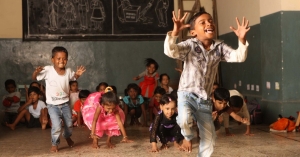Central Square Foundation and Centre for Social and Behaviour Change at Ashoka University collaborated to develop and empirically test behavior change interventions to increase parental engagement on FLN in two districts of Uttar Pradesh (view report here). Culminating in May 2022, the interventions showed statistically significant outcomes. In conversation with Dr. Sneha Shashidhara, the principal investigator on the project, we unpack how behavior sciences can inform intervention design for better outcomes.

Senior Research Consultant at the Centre for Social and Behaviour Change (CSBC)
Dr. Sneha Shashidhara is a senior research consultant at the Centre for Social and Behaviour Change, with a teaching position at the Psychology Department of Ashoka University. A Gates-Cambridge scholar, she did her PhD, studying the multiple demand network in the brain, at the University of Cambridge. Prior to that, she did her Master’s in Neuroscience at International Max Planck Research School (IMPRS), Goettingen, Germany.
Q1. Behavior science, over the last decade, has become a part of every policymaker’s toolkit. Even then, conversations seldom go beyond incentives and nudges for the target group. What do you think is the potential of using behavior science in improving learning outcomes, more specifically, in leveraging parents in learning?
The type of behavioral intervention depends on the type of behavior. One has to consider if the behavior is one-time, or a frequent one, i.e., a habit. Is the behavior an automatic one or does it require more cognitive effort? By working backward, we can tailor a suitable behavioral design intervention for a specific action. Unlike some simpler habit-like behaviors, say in the health sector where the behavior could be remembering to take medication, education involves more intricate actions, not always pre-determined, surpassing problems easily helped by nudges and reminders. The challenge then lies in effectively conveying crucial information for complex behaviors, utilizing behavioral science principles to distill the information into a digestible form and harnessing the right motivations to convert it to desired behavior. This underscores the potential of nuanced behavioral science applications to enhance the efficacy of information sharing, training, and communication for accessible behavior change.
Q2. Elaborate on how behavior design principles are translated into interventions. What did it look like in the Parent Behaviour Change study?
In the parents’ study, we first came up with an overarching principle. What is it that we want parents to do? Do we want them to teach? No. So what is their role in their children’s education? It is more akin to being coaches. A world class athlete’s coach need not have the same skill as that athlete. But he/she can be an effective coach if they can gauge the ability of the athlete and motivate and discipline them to work regularly and improve. We then created a kit to equip parents to be good coaches. They have the required knowledge as they use language and math (FLN) in their daily lives. What they needed was clarity on their role, easy activities to engage with their children on FLN, and heuristics to evaluate their work and keep track of their progress. All of this was created while keeping in mind the time and other constraints they may face on a daily basis. The glue in this kit was increasing their confidence to fulfill their role. Essentially, once we decided that our goal was to empower parents to become capable coaches, the rest fell into place.
Q3. Can one really measure behavior change? Elaborate in the context of the parent study.
Measuring behavior and impact of interventions are often difficult. In this study, to be able to see parents engage with children using our FLN activities consistently, was next to impossible. The impact would have been to see change in children’s FLN levels, which is a very high bar for such a short intervention. We thus rely on monitoring data during the intervention, and the analysis of baseline and endline survey questions. The nature of our intervention allowed us to measure to some extent whether parents engaged with the workbook (through calling the toll free number to get an audio version of the book) and WhatsApp group (through them sending photos and videos of them doing the activity with their children). In terms of survey tools, we used a few revealed preference measures that are often used in the field to elicit true answers as opposed to self reports, which may be affected by social desirability. For example, we used ‘willingness to pay’ to estimate the value they placed on the intervention, which increased in the workbook group. We also used vignettes to understand what parents considered as appropriate actions in different FLN related scenarios, as well as their confidence in their answer. Both these showed some increase in the WhatsApp group.
Q4. You are an expert on what theory has to offer on behavioral sciences and you have also had considerable experience applying/practicing those principles on the field. What has been your biggest learning?
This is a tough question, as there is so much that changes between a prototype created in the office/lab and the way it gets finally implemented on the field. For me, personally, it is realizing that people do not always interpret a question in the same way and thus one may get answers that are wildly unexpected. A lot of theories are based on data from WEIRD countries[1], and often samples consisting entirely of university students. The way one processes these questions, be it psychological tasks or economic games, is very different after having done one or two of them, and more so, after having studied the field. Therefore, one needs to calibrate every question to the study’s sample and appropriate translations are paramount.



